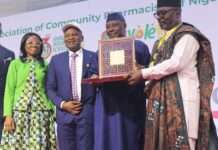By Nelson Okwonna
The National Institute for Pharmaceutical Research & Development (NIPRD) established through the Science and Technology act (1987) has as one of its mandates the development of herbal medicinal products (Phytomedicines) up to pilot stage for commercialisation. The Institute has over the years endeavored to achieve this, with NIPRISAN as an example in this regard.
The Institute currently collaborates with Traditional Medical Practitioners (TMP) towards fulfilling this mandate but the synergy and uptake of research results is slow or non-existent. Advocacy for effective and continuous collaboration with all key stakeholders in herbal drug industry in Nigeria is therefore important and urgently required. NIPRD is currently exploring new opportunities to achieve this.
Not all TMPs are aware of the benefits embedded in adding science to their medicinal herbal product, while the Nigerian Pharmaceutical industry has not fully tapped into the resources available for Pharmaceutical Research in NIPRD and in the utilization of its R & D results. These are some of the impediments in the drug development process from Nigerian medicinal plants, which have huge health and economic benefits for the nation.
Fostering effective uptake of Research results from NIPRD is one of the targets of the Institute’s strategic plan (2011-2015). This strategy is supported by the Nigerian Traditional Medicine Policy and the National Strategic Health Development Plan (NSHDP) of the Federal Ministry of Health. This is because it is widely recognised that such collaboration could bring huge health benefits to the populations, especially in controlling the HIV/AIDS pandemic and malaria; diseases which have placed a heavy burden on already weakened health systems in Nigeria and sub-Saharan Africa.
In pursuit of this objective, NIPRD organised a stakeholder’sforum on the 30th of October with the theme: Strengthening the Research and Development processes for theCommercialization of NIPRD Phytomedicines(A case study of antidiabetic phytomedicine).
The World bank sponsored forum was well attended by pharmaceutical researchers and Traditional medicine practitioners although there were not enough representation from industry.
The forum afforded NIPRD the opportunity to get feedback on its performance and expectations from the Nigeria Pharmaceutical Industry and Traditional Medical Practitioners.
It was also a time for stakeholders to determine the challenges and prospects of partnership between Traditional Medicine Practitioners (TMPs) and scientists involved in drug development suggesting way forward.
NIPRD also took the opportunity to highlight to the Nigerian Pharmaceutical industry, the commercialisation opportunities inherent in her drug development activities with special reference to the STEP B antidiabetic project.
At the end of the forum the participants arrived at the following communiqué:
- There is a huge market for traditional herbal medicine left untapped in Nigeria.
- There is a disconnect between the stakeholders in pharmaceutical research and development (Scientists, TMPs, and the industries)
- There is need for deliberate means of building confidence and trust amongst NIPRD, TMPs, Scientists and pharmaceutical industry.
- There is need for demand driven collaborative research involving scientists from universities, research institutes, pharmaceutical industry and TMPs.
- There is need to create awareness amongst stakeholders on the existing laws that protect intellectual properties of individuals, scientists, TMPs, and communities.
- There is need for funding research and development (R and D) through private-public and community partnership
- There should be increased exchange of researchers between research institutes, universities and pharmaceutical industries.
- There is need for diffusion of information to and from the TMPs, scientists and other stakeholders.













